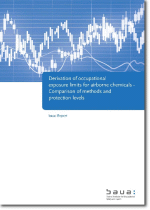Derivation of occupational exposure limits for airborne chemicals - Comparison of methods and protection levels
The derivation and setting of occupational exposure limits (OELs) is an important component of the risk assessment and risk management of chemicals in different national as well as international processes. On the EU level the harmonisation of airborne exposure limit values is a current issue, because for some substances different exposure limits for workplaces were yielded by occupational safety and health legislation on the one hand and by chemicals legislation on the other hand. Important steps in the process of setting OELs or analogue values are the determination of a point of departure based on adverse effects reported in toxicological studies and the application of assessment factors to bridge data gaps (regarding studies with different
exposure duration, differences between species and variability in sensitivity between humans).
The objective of this project was to analyse and disclose the differences between the current methods for deriving exposure limits and the resulting differences in protection levels. To achieve this,
- We analysed and compared the methodologies proposed or used at EU level and at national level in Germany
- Compiled data and used them for establishing distributions for assessment factors used for deriving exposure limits.
- With these distributions and their combinations, we analysed the level of protection achieved by the various methodologies and the reasons for differences.
-
Further, we investigated important instruments and methods for deriving exposure limits
- Dose-response modelling with the benchmark dose approach to determine the point of departure
- Probabilistic approaches to describe probabilities and uncertainties of exposure limits
- Methods for the modelling of kinetics of aerosols in the respiratory tract to describe respective interspecies differences and for determining a human equivalent concentration (HEC).
The overarching aim was to develop a common understanding of the necessary methodological steps in the setting of exposure limits and in this way to support harmonisation of the derivation of occupational exposure limits in the EU.
Bibliographic information
Title: Derivation of occupational exposure limits for airborne chemicals - Comparison of methods and protection levels.
1. edition. Dortmund: Bundesanstalt für Arbeitsschutz und Arbeitsmedizin, 2022. pages: 876, Project number: F 2437, PDF file, DOI: 10.21934/baua:bericht20220112
